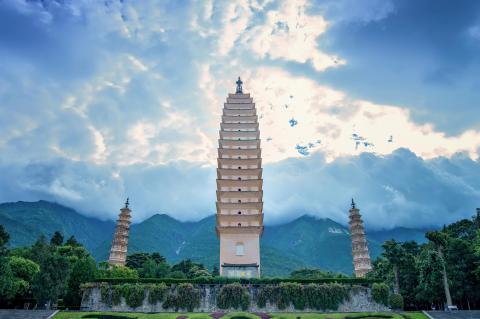Exploring Yunnan’s 5A-Lever Scenic Spot -Dali Chongsheng Three Pagodas Cultural Tourist Area


The Chongsheng Temple Three Pagodas Cultural Tourist Area is located within Dali Prefecture in Yunnan Province, China, situated 1.5 kilometers north of the ancient city of Dali. Originally a royal temple during the Dali Kingdom period, it is now a national 5A-level tourist attraction, integrating the scenic beauty of Cangshan Mountain and Erhai Lake, cultural relics, Buddhist culture, and leisure vacation. It is also the only national 5A-level tourist attraction in Dali.
Chongsheng Temple was first built during the Kaiyuan era of the Tang Dynasty and flourished in the Song Dynasty. It is renowned for its Five Treasures: the Three Pagodas of Chongsheng Temple, the Nanzhao Giant Bell, the Rain Copper Guanyin Statue, the “Buddha Capital” plaque, and the Three Saints Golden Statue. Nine kings of the Dali Kingdom once took monastic vows at Chongsheng Temple, making it a famous royal temple of the Nanzhao and Dali Kingdoms. It served as the prototype for the "Tianlong Temple" in Jin Yong's martial arts novel "Demi-Gods and Semi-Devils". During the Xianfeng and Tongzhi periods of the Qing Dynasty, the temple was destroyed by warfare and natural disasters, leaving only the Three Pagodas.

The temple seen today has been rebuilt, while the Three Pagodas are thousand-year-old relics. These three pagodas have become iconic structures of Yunnan and symbols of Dali. They include the Qianxun Pagoda and two smaller pagodas. These pagodas not only represent the splendor of the ancient Dali Kingdom but also stand as treasures of ancient Chinese architecture with their unique style and construction techniques.
The Qianxun Pagoda is the main pagoda of the three, standing 69.13 meters tall. It is a square-based, hollow brick pagoda with dense eaves and 16 stories, making it one of the tallest extant pagodas in China. It is a typical Tang Dynasty structure, similar in appearance to the Small Wild Goose Pagoda in Xi'an. Inside, the tower's walls are straight and vertically continuous, with wooden staircases leading to the top, offering a panoramic view of the ancient city of Dali. The Qianxun Pagoda exemplifies the Tang Dynasty's mastery of architectural art. The two smaller pagodas to the west of the main tower are each 42.4 meters tall, with 10 stories, and are octagonal, hollow brick structures with dense eaves. The three pagodas are arranged in a triangular pattern, presenting a magnificent sight from afar. Their elegant appearance and decorative design make them highly appealing whether viewed individually or as part of the ensemble with the main pagoda.
Visitor Guide:
Touring the Scenic Area: The entire scenic area is about 7 kilometers around and takes 3-5 hours to tour. To conserve energy, you can take an electric cart from the "scenic area entrance" to the "Main Hall of Chongsheng Temple" and visit from the inside out along the central axis, avoiding the uphill climb.
Photography Spots for the Three Pagodas:
Juying Pond: A small pond behind the Three Pagodas, a classic spot for capturing reflections.
Mirror of the Sky: Located in front of the Three Pagodas Plaza, free to photograph but requires waiting in line.
Three Pagodas Reflection Park: A small park outside the scenic area, the location of the paper ticket promotional photo, and the best spot for capturing reflections of the Three Pagodas.
Wanghai Tower: The highest building in the temple, offering a distant view of Cangshan Mountain and Erhai Lake.
Shanmen of Chongsheng Temple: The entrance of Chongsheng Temple, the largest and most exquisite archway.
Transportation Guide:
Airplane:
Dali has one airport - Dali Fengyi Airport. For those traveling a long distance, flying saves time, but tickets can be expensive during holidays. Alternatively, you can fly directly to Lijiang Airport, which might be cheaper. There is a direct shuttle bus from Dali Airport to the ancient city of Dali, costing 25 RMB per person and taking about 1 hour.
High-Speed Rail:
There are direct high-speed trains to Dali from Guangzhou, Guiyang, Chongqing, and Chengdu. It's convenient, fast, and affordable. However, travelers from northern and southeastern coastal cities need to transfer at Kunming. From Lijiang, the high-speed train to Dali takes as little as 1 hour and 39 minutes.
Train:
You can take a train to Dali from cities like Kunming and Lijiang. Upon arrival at the train station, you can choose to travel to various attractions by bus, taxi, or bicycle. There is also transportation to the Chongsheng Temple Three Pagodas Cultural Tourist Area from the train station.
Bus: There are tourist buses from Lijiang to Dali (approximately 3-4 hours) and from Kunming to Dali (most buses from Kunming to Dali take 7 hours, but taking the bus from Kunming West Bus Station to Dali via the highway takes about 4-5 hours, costing 100-150 RMB).
Within Dali City: The ancient city of Dali is 1.2 kilometers from the Three Pagodas, a 20-minute walk. You can take bus number 19 from the north gate of the ancient city to the Three Pagodas Park station or spend 4 RMB to take a horse-drawn carriage.
(These transportation methods are for reference only. Please check the corresponding transportation tools according to the actual situation.)








